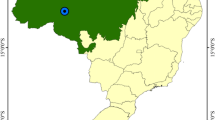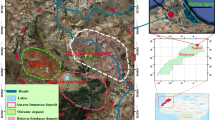Abstract
Purpose
UK local authorities are required by environmental regulations to keep a public register of contaminated land. In many towns and cities, there is growing concern of allotment holders about the quality of their allotment soils. Limited information on soil chemistry is available for the southwest of England. This work was carried out to assess whether any allotment and park soil in Bristol could be defined as “contaminated”.
Materials and methods
Samples of soil, sediments and bedrock material were analysed for “pseudo-total” As, Cd, Cr, Cu, Mn, Ni, Pb, Zn and Fe by inductively coupled plasma optical emission spectrometry. Baseline heavy metal levels for this region were estimated on the basis of the composition of soil parent material, whilst sediment data provided information on the effect of chemical and physical weathering in the Bristol Avon River catchment area. UK Soil Guideline Values and statistical analysis were used to identify anomalies and sites requiring further investigation.
Results and discussion
Potentially contaminated sites were found at Durdham Downs Park (Pb, Zn, As), Troopers Hill Nature Reserve (Cu), Atwood Drive Allotments (Cd) and Packers Allotments (As). Estimated “upper threshold ranges” of the heavy metals of concern can be used as a preliminary site-specific screening tool to identify anomalies requiring more in-depth investigation. This approach takes into account that the sandstone underlying the Bristol district is naturally enriched in some heavy metals, particularly As, Ni and Cr. The very strong positive correlations between pairs of the elements Cr, Ni, Pb, Zn, Cd, Cu and As in the pelite fraction (<63 μm) of stream sediments point to a natural origin of these heavy metals.
Conclusions
There is evidence of heavy metal enrichment in some of the allotment and park soils analysed. In addition to the influence of anthropogenic sources, the bedrock of the Bristol district can account for much of the soil As, Cr and Ni. Owing to the natural high background levels of some elements in the underlying bedrock, published “ambient” soil heavy metal levels for England are not applicable to the city of Bristol.







Similar content being viewed by others
References
Agency E (2002) Industry in Avonmouth. A public guide to pollution management. Environment Agency, Exeter
Alloway BJ (2004) Contamination of soils in domestic gardens and allotments:a brief overview. Land Contam Reclam 12(3):179–187
Barraclough D (2007) UK Soil and Herbage Pollutant Survey. UKSHS report no. 1. Introduction and summary. Environment Agency, Bristol
Barton CM, Strange PJ, Royse KR, Ferrant AR (2002) Geology of the Bristol District: a brief explanation of the geological map Sheet 264 Bristol. British Geological Survey, Nottingham
Breward N (2007) Arsenic and presumed resistate trace element geochemistry of the Lincolnshire (UK) sedimentary ironstones, as revealed by a regional geochemical survey using soil, water and stream sediment sampling. Appl Geochem 22:1970–1993
Bristol City Council (2006) Bristol Parks allotment strategy (draft) 2007–2012. Bristol Parks, Department of Culture and Leisure, Bristol City Council, Bristol
Bristol City Council (2007a) Bristol parks. A management plan for Clifton and Durdham Downs 2007–2012. Bristol City Council, Bristol
Bristol City Council (2007b) Bristol parks. A management plan for Troopers Hill Nature Reserve. Bristol City Council, Bristol
Bristol City Council (2008) Bristol’s parks and green space strategy. Bristol City Council, Bristol
Brown SL, Chaney RL (1999) A rapid in vivo procedure to characterize the effectiveness of a variety of in situ lead remediation technologies. In: Wenzel WW, Adriano DC, Alloway B et al (eds) 5th International Conference on the Biogeochemistry of Trace Elements. Proceedings of extended abstracts, Vienna, pp 419–429
Burkitt A, Lester P, Nickless G (1972) Distribution of heavy metals in the vicinity of an industrial complex. Nature 238:327–328
Cave MR, Wragg J, Palumbo B, Klinck BA (2003) Measurement of the bioaccessibility of arsenic in UK soils. R&D Technical Report P5-062/TR02. Bristol, Environment Agency
Coughtrey PJ, Jones CH, Martin MH, Shales SW (1979) Litter accumulation in woodlands contaminated by Pb, Zn, Cd, and Cu. Oecologia 39:51–60
Culbard EB, Thornton I, Watt J, Wheatley M, Thompson M (1988) Metal contamination in British urban dusts and soils. J Environ Qual 17:226–234
DCLG (2006) Housing in England 2004/05. A report principally from the 2004/05 Survey of English Housing. Department of Communities and Local Government, London
DEFRA and Environment Agency (2002) CRL10 SGV 1–10: soil guideline value reports for arsenic, cadmium, chromium, nickel, lead, mercury and selenium. Environment Agency, Bristol
George D, Mallery P (2009) SPSS for Windows step by step: a simple study guide and reference, 17.0 update (10th edition). Ally & Bacon, Boston
Green (1992) British Regional Geology: Bristol and Gloucester region (third edition). HMSO, London
Hursthouse A, Tognarelli D, Tucker P, Marsan FA, Martini C, Madrid L, Madrid F, Diaz-Barrientos E (2004) Metal content of surface soils in parks and allotments from three European cities: initial pilot study results. Land Contam Reclam 12(3):189–196
Johnson CC, Breward N (2004) G-BASE geochemical baseline survey of the environment. Commissioned Report CR/04/016N. British Geological Survey, Keyworth
Knight K (2004) Part IIA and the identification and remediation of contamination in residential gardens in Totley, Sheffield, UK. Land Contam Reclam 12(3):253–260
Levesque R (2007) SPSS programming and data management: a guide for SPSS and SAS users. SPSS Inc, Chicago
Long ER, MacDonald DD, Smith SL, Calder FD (1995) Incidence of adverse biological effects within ranges of chemical concentrations in marine and estuarine sediments. Environ Manag 19:81–97
Loveland PJ, Whalley WR (1991) Particle size analysis. In: Smith KA, Mullis CE (eds) Soil analysis: physical methods. Marcel Dekker, New York
McGrath SP, Cunliffe CH (1985) A simplified method for the extraction of the metals Fe, Zn, Cu, Ni, Cd, Pb, Cr, Co and Mn from soils and sewage sludges. J Sci Food Agr 36:794–798
McGrath SP, Loveland PJ (1992) The soil geochemical atlas of England and Wales. Chapman and Hall, London
Moreno N, Querol X, Andrés JM, Stanton K, Towler M, Nugteren H, Janssen-Jurkovicová M, Jones R (2005) Physico-chemical characteristics of European pulverized coal combustion fly ashes. Fuel 84:1351–1363
Nathanail CP, McCaffrey C, Haynes D (2006) Assessing exposure to pedogenic arsenic contamination at a dwelling in Northamptonshire, UK: a case study. Soil Use Manag 21:508–517
Nowack B, Obrecht J-M, Schluep M, Schulin R, Hansmann W, Köppel V (2001) Elevated lead and zinc contents in remote alpine soils of the Swiss National Park. J Environ Qual 30:919–926
Oomen AG, Rompelberg CJM, Bruil MA, Dobbe CJG, Pereboom DPKH, Sips AJAM (2003) Development of an in vitro model for estimating the bioaccessibility of soil contaminants. Arch Environ Contam Toxicol 44:281–287
OSPAR Commission (2004) Overview of Contracting Parties’ national action levels for dredged material. OSPAR Commission, Biodiversity Series, London
Pan J, Plant JA, Voulvoulis N, Oates CJ, Ihlenfeld C (2010) Cadmium levels in Europe: implications for human health. Environ Geochem Health 32:1–12
Penny J (2005) Bristol at work. Breedon, Derby
Pless-Mulloli T, Air V, Vizard C, Singleton I, Rimmer D, Hartley P (2004) The legacy of historic land-use in allotment gardens in industrial urban settings: Walker Road allotment in Newcastle upon Tyne, UK. Land Contam Reclam 12(3):239–251
Prasad LR, Nazareth B (2000) Contamination of allotment soil with lead: managing potential risks to health. J Public Health Med 22(4):525–530
Reimann C, Filzmoser P, Garrett RG (2005) Background and threshold: critical comparison of methods of determination. Sci Total Environ 346:1–16
Rieuwerts JS, Searle P, Buck R (2006) Bioaccessible arsenic in the home environment in southwest England. Sci Total Environ 371:89–98
Roussel H, Waterlot C, Pelfrêne A, Pruvot C, Mazzuca M, Douay F (2010) Cd, Pb and Zn oral bioaccessibility of urban soils contaminated in the past by atmospheric emissions from two lead and zinc smelters. Arch Environ Contam Toxicol 58(4):945–954
Ruby MV, Davis A, Schoof R, Eberle S, Sellstone CM (1996) Estimation of lead and arsenic bioavailability using a physiologically based extraction test. Environ Sci Technol 30(2):422–430
Sanghoon L, Jeongsang H (1997) Geochemistry of leachate from fly ash disposal mound. J Environ Sci Health A32(3):649–669
Singh BR, MacLoughlin MJ (1999) Cadmium in soils and plants. Kluwer Academic, Dordrecht
Thien SJ (1979) A flow diagram for teaching texture by feel analysis. J Agr Educ 8:54–55
Toogood JA (1958) A simplified textural classification diagram. Can J Soil Sci 38(1):54–55
Tukey JW (1997) Exploratory data analysis. Addison-Wesley, Reading
Xu J, Thornton I (1985) Arsenic in garden soils and vegetable crops in Cornwall, England: implications for human health. Environ Geochem Health 7:131–133
Acknowledgements
The author would like to thank Dave Molesworth and Rhiannon Davies for their help during fieldwork, Andrew Taylor for the ICP-OES analyses, Joseph Lartey for undertaking much of the soil sampling and soil preparation during the initial reconnaissance study, and Emma Waters for map production. Stephen Clamping (allotments manager at Bristol City Council), the parks managers, and allotment holders are gratefully acknowledged for allowing access to allotments and parks.
Author information
Authors and Affiliations
Corresponding author
Additional information
Responsible editor: Jörg Römbke
Electronic supplementary material
Below is the link to the electronic supplementary material.
Table T1
Sampling locations and type of rock samples (DOC 164 kb)
Fig S1
Tukey box plots for pseudo-total Fe2O3 and Mn in the topsoil (15 cm) of six parks/green areas and six allotments (DOC 259 kb)
Rights and permissions
About this article
Cite this article
Giusti, L. Heavy metals in urban soils of Bristol (UK). Initial screening for contaminated land. J Soils Sediments 11, 1385–1398 (2011). https://doi.org/10.1007/s11368-011-0434-4
Received:
Accepted:
Published:
Issue Date:
DOI: https://doi.org/10.1007/s11368-011-0434-4




